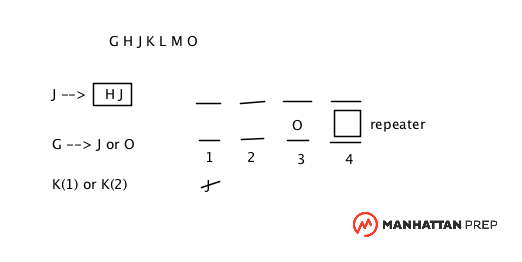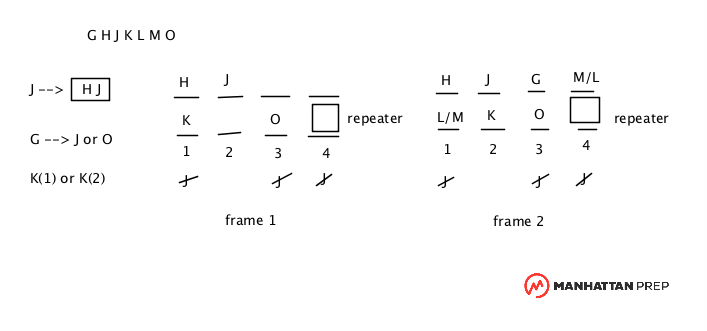The diagram is no longer exist... mind uploading it again?
Thanks
LSAT Forum
6 postsPage 1 of 1
-

- esthertan0310
-
Thanks Received: 0
-
Jackie Chiles

- Posts: 33
- Joined: March 03rd, 2015
-

- ManhattanPrepLSAT1
-
Thanks Received: 1909
-
Atticus Finch

- Posts: 2851
- Joined: October 07th, 2009
- This post thanked 2 times.
-

- brian.diliberto
-
Thanks Received: 0
-
Vinny Gambini

- Posts: 4
- Joined: July 16th, 2015
Re: Diagram
delete
Last edited by brian.diliberto on Fri Dec 11, 2015 7:33 pm, edited 1 time in total.
-

- ManhattanPrepLSAT1
-
Thanks Received: 1909
-
Atticus Finch

- Posts: 2851
- Joined: October 07th, 2009
- This post thanked 1 time.
Re: Diagram
Happy to help!
Week 1: J cannot go in week 1, since there's no way to place H in a week before that.
Week 3: J cannot go in week 3, since that would rule out having J or O in the same week as G (remember that the repeater can't go in week 3).
Week 4: J cannot go in week 4 since that would not leave J or O to go with G. O in week 3 would be with H and would be blocked from G. J in week 4 cannot be the repeater since that would require a second H, would be the only J and so would have to go with G, who would have to be the repeater. But since G requires another J or O, the scenario falls apart.
Obviously, recognizing that J cannot go in week 4 may be something you only arrive at as you work through Q20.
Week 1: J cannot go in week 1, since there's no way to place H in a week before that.
Week 3: J cannot go in week 3, since that would rule out having J or O in the same week as G (remember that the repeater can't go in week 3).
Week 4: J cannot go in week 4 since that would not leave J or O to go with G. O in week 3 would be with H and would be blocked from G. J in week 4 cannot be the repeater since that would require a second H, would be the only J and so would have to go with G, who would have to be the repeater. But since G requires another J or O, the scenario falls apart.
Obviously, recognizing that J cannot go in week 4 may be something you only arrive at as you work through Q20.
-

- andrewgong01
-
Thanks Received: 61
-
Atticus Finch

- Posts: 289
- Joined: October 31st, 2016
Re: Diagram
ManhattanPrepLSAT1 Wrote:Happy to help!
Week 1: J cannot go in week 1, since there's no way to place H in a week before that.
Week 3: J cannot go in week 3, since that would rule out having J or O in the same week as G (remember that the repeater can't go in week 3).
Week 4: J cannot go in week 4 since that would not leave J or O to go with G. O in week 3 would be with H and would be blocked from G. J in week 4 cannot be the repeater since that would require a second H, would be the only J and so would have to go with G, who would have to be the repeater. But since G requires another J or O, the scenario falls apart.
Obviously, recognizing that J cannot go in week 4 may be something you only arrive at as you work through Q20.
Just curious, but how would we normally think of making these deductions to conclude that J must go in 2 and will only go in two and not repeat itself. From retrospect after knowing the game, I can see how it is the case but were there any hints in the set up/rules for us to make this inference.
I didn't solve it by frames and it took be around 10:45 to finish this game on my first try; I will try it with frames around the K rule (as shown above) in the near future. Framing around HJ from hindsight would not work since J can only go into one spot ( I guess attempting this frame may answer my above question but I don't think this is the fatest way to realize this deduction) . I think framing around G would work too because G is a non-repeating element (if G repeats , we must repeat J or O with it and O is not a repeating element) so G can go either with "O" in three or we put G with J in the second position since we know J can only go in two (however, this frame would work only if we knew only J=2 when we first attempt the game). That said, I am not sure if this game is faster with frames because it would have taken a few mins to get to these inferences and the frame and Q19, Q20, Q21 were also pretty fast to solve via prior work through the frames Q22,23,24 will force you to create.
Would you say there was any key takeaways from this game? Currently I see the key take away as writing the unless rule such that the sufficient condition is a positive term and that when the game board is relatively small pay attention to the limited options certain variables with restrictions can go into.
-

- FlaneurR675
-
Thanks Received: 0
-
Vinny Gambini

- Posts: 5
- Joined: September 29th, 2017
Re: Diagram
1. Seven elements, GHJKLMO, will be assigned to eight slots (2-1-1-1-1-1-1)
2. The slots are divided into four weeks, with two slots per week, and the order of elements in the same week won't matter
3. If J is advertised, H is advertised in the preceding week; if H is not advertised in a week preceding J, J isn't advertised; the inference here is that H can go anywhere but J can only go to weeks 2, 3, and 4
4. Product advertised twice must be advertised in week 4 but not week 3; the twice-advertised product will be assigned to 1+4 OR 2+4 only
5. If G is advertised, then J or O is also advertised with G; in a week without J or O, G is not advertised; this means G cannot be advertised twice
6. K is advertised during one of the first two weeks; this doesn't rule out K being advertised once more in week 4
7. O is fixed at week 3; this means O is advertised only once as per rule 4
In all games, we need to combine each given rule to make inferences. Here, rule 4 is the rule that applies most generally and can be combined to rules 3, 5, 6 and 7. I have already done that for rules 5 to 7. As for rule 3, we can now infer that, because of rule 4, J cannot appear twice but H can. From the rules we know that G, J and O definitely cannot appear twice.
Speaking of combining rules, we need to focus on linkages between J, O and G as they appear multiple times across the rules. H and J is a block across two continuous weeks, and we can hypothesize situations when HJ appear. There are actually few possibility as to where the HJ block can appear: in week 1-2 they can appear as a block, but this is not the case in week 2-3 and 3-4, and we can fix HJ in weeks 1-2 only. This is because if J is in week 3, that means G cannot appear anywhere else due to rule 5 and our knowledge that none of them can appear twice. Also, if J is in week 4, that means G must appear with J in that week, but in that case rule 4 is breached. With HJO fixed in the first three weeks, we can also see that G can only appear in week 2 or 3, due to rule 5. With that in mind we can begin attacking the questions.
This is the most difficult game in the test, and there are multiple layers of inferences to be made before you can draw a meaningful diagram. The lesson here is that you should save time on easier games, so that you have at least ten minutes to deal with a game like this one. Before starting your last game, even if you have more time left than you usually do after finishing three games, you should never be mentally complacent about your situation.
2. The slots are divided into four weeks, with two slots per week, and the order of elements in the same week won't matter
3. If J is advertised, H is advertised in the preceding week; if H is not advertised in a week preceding J, J isn't advertised; the inference here is that H can go anywhere but J can only go to weeks 2, 3, and 4
4. Product advertised twice must be advertised in week 4 but not week 3; the twice-advertised product will be assigned to 1+4 OR 2+4 only
5. If G is advertised, then J or O is also advertised with G; in a week without J or O, G is not advertised; this means G cannot be advertised twice
6. K is advertised during one of the first two weeks; this doesn't rule out K being advertised once more in week 4
7. O is fixed at week 3; this means O is advertised only once as per rule 4
In all games, we need to combine each given rule to make inferences. Here, rule 4 is the rule that applies most generally and can be combined to rules 3, 5, 6 and 7. I have already done that for rules 5 to 7. As for rule 3, we can now infer that, because of rule 4, J cannot appear twice but H can. From the rules we know that G, J and O definitely cannot appear twice.
Speaking of combining rules, we need to focus on linkages between J, O and G as they appear multiple times across the rules. H and J is a block across two continuous weeks, and we can hypothesize situations when HJ appear. There are actually few possibility as to where the HJ block can appear: in week 1-2 they can appear as a block, but this is not the case in week 2-3 and 3-4, and we can fix HJ in weeks 1-2 only. This is because if J is in week 3, that means G cannot appear anywhere else due to rule 5 and our knowledge that none of them can appear twice. Also, if J is in week 4, that means G must appear with J in that week, but in that case rule 4 is breached. With HJO fixed in the first three weeks, we can also see that G can only appear in week 2 or 3, due to rule 5. With that in mind we can begin attacking the questions.
This is the most difficult game in the test, and there are multiple layers of inferences to be made before you can draw a meaningful diagram. The lesson here is that you should save time on easier games, so that you have at least ten minutes to deal with a game like this one. Before starting your last game, even if you have more time left than you usually do after finishing three games, you should never be mentally complacent about your situation.
6 posts Page 1 of 1

